
Design a way for residents to imagine Southwark
in 2030
Company
Southwark Council
Timeline
1 month
Context
Reimagining Southwark in 2030
We collaborated with Southwark Council to “design a way for residents to imagine Southwark in 2030”. Throughout the project brief, we delved into the potentialities of creating an open space for community members to discuss their expectations of the council and their vision for their surroundings.
My Role
As a user experience designer for this project, my responsibilities included working closely with stakeholders to find a way away from surveys and user interviews for participants to imagine their borough in 2030 and the future they wish to have with their community
Outcome
Our proposal for the brief was a "Southwark 2030" game toolkit, which employed prompt cards to guide citizens in constructing narratives about the future. We conducted extensive testing with the community to refine our prototype and communicate its final iteration to the council.
Process
What are the current Southwark conversations like?
At present, the council conducts 'Southwark 2030' conversations via various online and offline channels to engage with the citizens. Christine, from the council, extended an invitation for us to participate in one of their conversations to gain insights into the nature of these discussions and the extent of citizen engagement.

Snapshot of "Southwark Conversation 2030"
Experiencers
Who is our target audience?
Continuing our journey, we identified two distinct user groups within the Southwark 2030 conversations. To comprehensively understand and enhance the experiences of each group, we actively engaged with them through methods such as interviews and observations, all while setting a clear project goal.
Project Goal
Make the conversations scalable adaptable to the young audience while adapting a new way to imagine the borough: inclusive and accessible

Project Scope
On-site experience for the children of the borough
Off-site experience for council members to look at the data
On-site Experience
There is value in talking to children about the future; they are idealistic and not weighed down by ‘what is possible,’ ‘what is feasible’, ‘what is realistic’ - they just know what they would want to happen, not limited by what is ‘practical’
So, How might we enhance children's engagement and support smooth facilitation?"
On-site Solution I
Help children engage in conversations
better by giving them a sense of ownership
with generative prompts
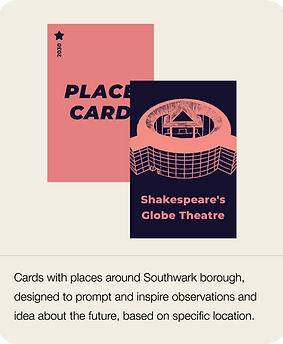
Generative Prompts
During our research and testing phase, we noticed that lack of visuals and imagery led to bland answers, whereas imagery helped children expand on their thoughts. In this form of elicitation, the game metaphor emerged as a productive means of understanding and organising participation. We carefully selected and designed artefacts such as object and place cards, along with the board, accompanied by a set of rules to guide activities toward the desired outcome—rich, imaginative, future-based narratives with actionable insights for the borough.
On-site Solution II
Help children engage through gamification aspect to enhance engagement and captivate their interest by situating the game
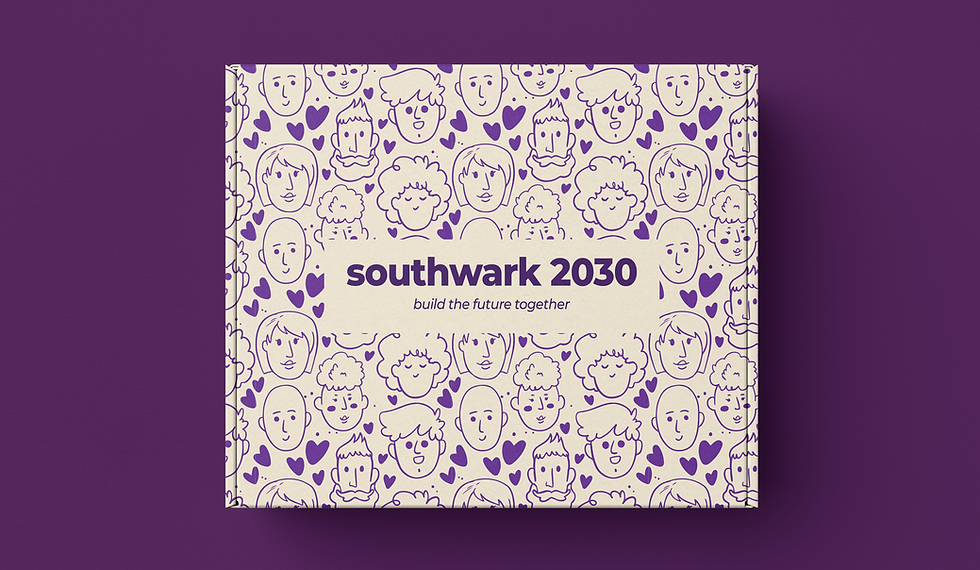

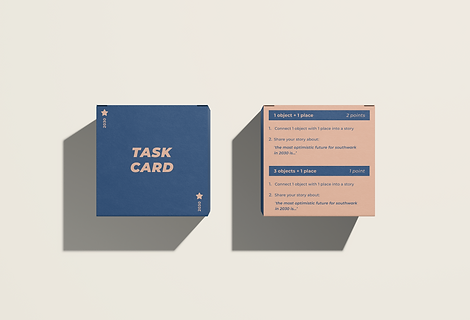
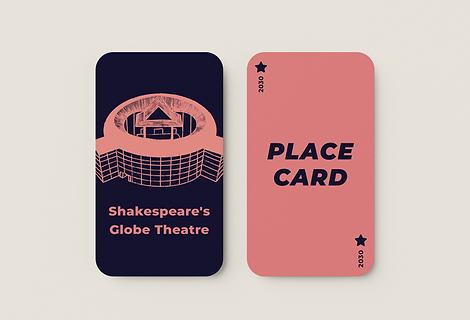

Southwark 2030 Game Toolkit
Our central objective revolved around the synthesis of key elements into a versatile toolkit, enabling effortless replication and engagement in the absence of our direct involvement. To achieve this, we curated an exhaustive rulebook that elucidates the game's objectives, gameplay intricacies, the utility of individual components, the target audience, and the methodology for data collection. This strategic compilation ensures a seamless and independent user experience, showcasing the adaptability and accessibility of our design solution.
On-site Solution Impact
As children become more engaged, the conversations yield
richer information about the borough and its future, while the
facilitation of the conversations eases
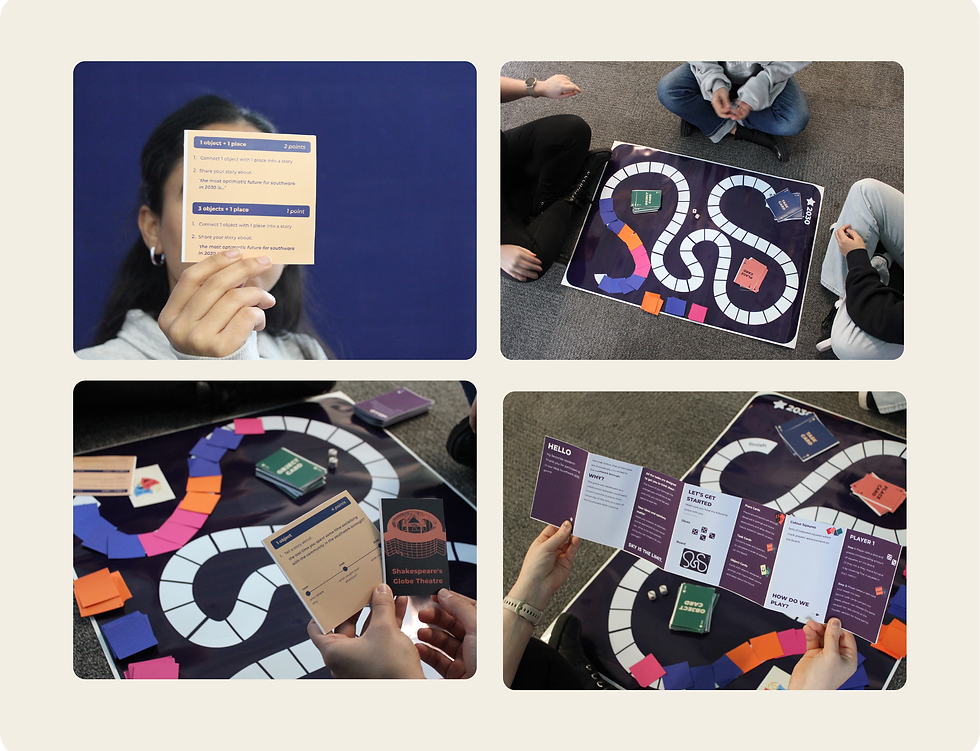
User Testing Result
We conducted testing with a diverse group of 12 participants, including 10 students under 18, with 2 having learning disabilities, and 2 staff members. Our session at Southwark College was highly successful, yielding valuable insights for the Southwark 2030 initiative. While we made minor adjustments to the final version, the method proved effective with both staff and students.
The game context we created established a secure environment for exploration and imagination, facilitating more comfortable and creative problem-solving. This approach supported participants in thinking innovatively, establishing connections between objects and places, and constructing meaningful narratives.
Off-Site Solution
Help council members make the conversations scalable and reachable to a wider audience
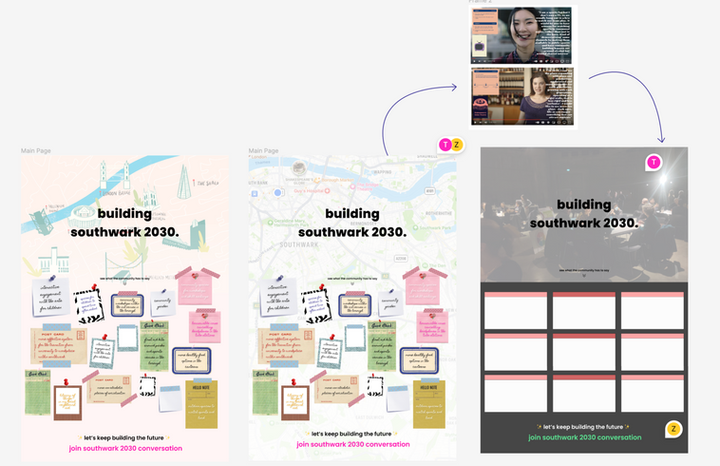
Southwark 2030 Web Vision
Our aim through the online vision board was to have community members something to look back on, their responses - reaching a wider audience, members reading each other's ideas for the future and having a place for the conversations to live in - a tangible way to preserve them,
Reflection
Due to time constraints, we could not handover the website idea to the council as this was our secondary focus throughout the project, whereas making a medium to facilitate and make conversations engaging was the primary goal of the project brief
Learnings
Overall, the project communicated the value of the community through just the conversations, while the toolkit acted as a medium to converse. Working with Southwark Council helped us understand the importance of community building and co-creating with people and the importance of participatory methods in design
Importance of design-led research practice
In the course of this project, our central emphasis was on perceiving design as a tool for conducting research, aligning with Frayling's perspective on research through design. Our approach involved the utilisation of methods like probes and toolkits, distinguishing itself from conventional techniques such as interviews, surveys, and focus groups. In contrast to the traditional research-led design practice, the design-led approach yielded a more comprehensive dataset, challenging the hierarchical nature of conventional research methodologies.